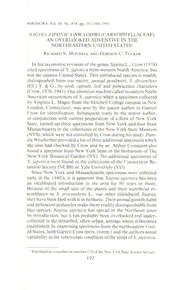
SAGINA-JAPONICA (SW) OHWI (CARYOPHYLLACEAE), AN OVERLOOKED ADVENTIVE IN THE NORTHEASTERN UNITED-STATES PDF
Preview SAGINA-JAPONICA (SW) OHWI (CARYOPHYLLACEAE), AN OVERLOOKED ADVENTIVE IN THE NORTHEASTERN UNITED-STATES
RHODORA, Vol. 93, No. 874, pp. 192-194, 1991 OHWI SAGINA JAPONICA (CARYOPHYLLACEAE), (SW.) AN OVERLOOKED ADVENTIVE THE IN NORTHEASTERN UNITED STATES' Richard Mitchell and Gordon Tuckler C. S. Crow In his taxonomic revision of the genus Sagina (1978) L., cited specimens of japonica from western North America, but S. not the eastern United States. This introduced species readily is distinguished from our native, annual pearlwort, decumbens S. & T. G., by seed, capsule, leaf and pubescence characters (Ell.) Our (Crow, was North 1978, 1981). attention called to eastern first American when occurrences of japonica specimen a collected 5". New by Magee from campus Virginia L. the Mitchell College in London, was Connecticut, sent by the junior author Garrett to Crow for identification. Subsequent study by the senior author, New in conjunction with current preparation of of York a flora New turned up specimens from York and from State, three four New Museum Massachusetts of York in the collections the State (NYS), which were not consulted by Crow during Pam- his study. Weatherbee provided of specimens which ela a three additional list she also had checked by Crow and by Arthur Cronquist also us. New found specimen from York herbarium The a State in the of New No York Garden Botanical (NY). additional specimens of japonica were found S, in the collections of the Connecticut Bo- (NCBS) tanical Society or Yale University (YU). New York and Since Massachusetts specimens were collected early in the 1940's, apparent that Sagina japonica has been is it an established introduction in the area for 50 years or more. Because of the small size of the plants and their superficial re- pwcumbens semblance to 5. L., our other introduced Sagina, they have been filed with in herbaria. Their annual growth habit it and make them pubescent peduncles from readily distinguishable that species. Sagina japonica has spread in the Northeast since introduction, but has probably been overlooked and under- its it collected in the disturbed, often urban, settings where becomes it examining specimens from established. In the northeastern Unit- Crow comm.) ed States, both Garrett (pcrs. and the authors noted variability in the tuberculate condition of the seeds of japonica. S. Published as conlribulion number 670 of the New York Slate Science Service 192 Mitchell and Tucker— Sagina 193 1991] At one specimen {Wilkins 14621) has prominently and least densely tubercled seeds, while the remaining specimens from our Crow comm.) area have pebbled seed surfaces. (pers. suggests that may variation imply multiple introduction of the species into this North America. eastern New York and For those wishing to identify Sagina species in New England, the following diagnostic key provided: is KEY TO THE SAGINA SPECIES IN NEW ENGLAND -NEW YORK AREA Petals not showy, about equaling the length of sepals; flowers 1. terminal, solitary, or a second one borne at the ultimate node; upper not bearing succulent short-shoots leaf axils (2) Perianth parts in annuals with ascending or decumbent, 2. 5's; and stems not often capillary slender taproots, strongly by tufted or spreading offshoots (3) Seeds triangular with a dorsal groove; capsules pale, 3. longer than broad; pedicels usually glabrous (sepals may be minutely glandular at base); leaves not suc- decumbcns culent S, Seeds dark brown, plump, lacking a dorsal groove; cap- 3. sules globose; pedicels glandular pubescent (at least the upper halves); leaves succulent .... S. japonica on same mat- 2. Perianth parts in 4's (rarely 5's the plant); wiry perennials, spreading by offshoots ted, procumbens S. Petals showy, about twice the length of sepals; flowers often 1. more than 2 per inflorescence; upper leaf axils bearing dense, succulent short-shoots nodosa S, New New Specimens examined: Connecticut: London Co.: London, Mitchell College Campus, dry soil by building, 7 July 1988, Magee s.n. (conn, ncbs, nebc, End nha). Massachusetts: Berkshire Co.: Egremont, Jug Road, 27 June 1990, Weatherbce 2990 (nha); Florida, base of Torrey Mountain Road, 23 June 1990, (nha); Williamstown, driveway, 17 June 1990, Weatherbce 2948 ff'^£3///<^/'/7e^2956 (nha). Hampshire Co.: Northampton, streets, 27 June 1941, O. L. Schreiber 234 (nys); Amherst, ''Inwood" lawn, 23 June 1950, R.E. Torrey s,n. (nys); Amherst, Hammond Sunset Avenue, 18 June 1973, H.D. 680 1-h (nys); Hadley, North New Maple Street, 3 July 1978, H.E. Ahles 85437 (nys). York: Bronx Co,: Pelham Chemung Bay Park, Sect. 29, 14 June 1947, H.E. Ahles 1409 (nys); Co.: Elmira, curbings and lawns, ''1945," SJ. Smith 4797 (nys); Kings Co.: Prospect Park, Rhodora 194 93 [Vol. Moon BrooklN'n, N.Y. in grassy soil, 8 June 1957, Monachino 597 (ny); Ulster Co.; Hollow Rd. 2 mi. w. of W, Shokan, Town of Olive, growing in dampish soil of & shaded roadside, 5 July 987, Karl Brooks 7074 Paul Ilulh (nys). Pennsylvania: 1 1 Museum Berks Co.: lawn of Reading Grounds, IVilkens 14621 (nha). LITERATURE CITED Crow, A G. 1978. taxonomic revision Sagina (Caryophyllaceae) North E. oi' in Rhodora America. 80: 1-91. 1981. The systematic significance of seed morphology in Sagina (Car\'0- . phyllaceac) under scanning electron microscopy. Briltonia 31: 52-63. BIOLOGICAL SURVEY NEW YORK MUSEUM STATE NEW YORK ALBANY, 12230
